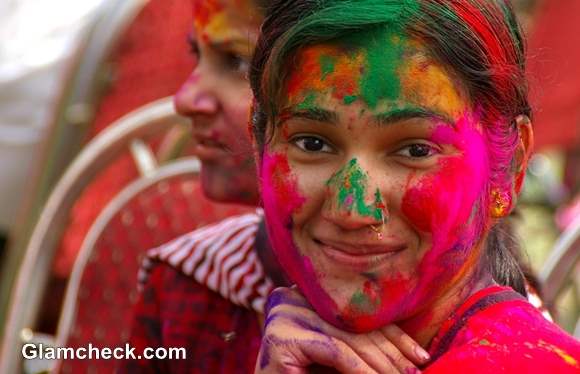At the onset of spring and to mark the beginning of the Hindu calendar for certain sects, the festival of Holi is celebrated on the full moon day of the Hindu lunar month –Phagun. As per the Gregorian calendar, this usually falls in the months of February or March. Well known for the fun, frolic, colors and gaiety that this festival symbolizes, Holi is widely celebrated in all parts of India and especially in the Northern region.
 Holi -The Indian Festival of Colors
Holi -The Indian Festival of Colors
Holi is being celebrated in 2013 on the 27th of March.
Legends about Holi
Holika popularly known as Holi celebrates the victory of good over evil. As per an ancient legend, the all powerful demon king and tyrant Hiranyakashyap wanted only himself to be worshipped in his entire kingdom. His own son Prahlad however, was an ardent devotee of lord Vishnu and despite various attempts of his father to change his devotion from the Lord on to himself, all his attempts failed.
Hiranyakashyap sought the help of his sister Holika. Holika had been gifted the boon of never to be burnt in any fire. Prahlad was summoned by his father and asked to sit in the lap of Holika who was to step inside a raging fire. Hiranyakashyap believed that this would burn his son to ashes, while the sister would have been saved due to her boon. Prahlad, being the ardent devotee of Lord Vishnu prayed hard and by the grace of the Lord, Holika got burnt whereas Prahlad was saved.
Holi the festival is hence celebrated to commemorate the victory of good over evil, devotion over debauchery.
In some parts of the country, such as Bengal and Orissa, this day is also celebrated to commemorate the birth of Chaitanya Mahaprabhu.
Celebrations of the festival
The most boisterous and colorful of all the festivals, Holi is also known as Dhulendi, Dol Jatra and Basantotsav in different parts of the country.
Usually celebrated over a period of two days, the first day marks the beginning of the Holi festival and is commonly called Choti Holi or Holika dahan. On this day, as the sun sets, a bonfire is lit, which is symbolic of Holika being burnt. It is common to worship the fire as it means victory of true devotion.
The next day Holi is celebrated. On this day, people meet and greet each other and play with colors – both wet and dry ( abir). The festival is considered to be a great equalizer where the rich and poor, old and the young all play together forgetting all the barriers of caste, creed, age and riches.
In the Western state of Gujarat it is common to hang a pot of buttermilk high up on the streets with the boys attempting to reach it by making human pyramids and the girls throwing colors and water on them to prevent them from doing so. This activity is reminiscent of Lord Krishna trying to steal butter from the ladies or gopis.
Even more playful is the way holi celebrated in the central part of India – Uttar Pradesh, in particular, the land of the Lord Krishna. Here holi is celebrated for almost two weeks. The festival is widely celebrated in the cities of Mathura, Barsana and Vrindavan. Devotees throng the temples, offering prayers and sweetmeats to Lord Krishna. Closer to the day of Holi, it is commonplace to pour water over passer-bys and strangers and the best part is nobody seems to mind! The ‘Lathmar-holi’ played in the town of Barsana is famous, where the women folk teasingly shoo away the suitors with sticks or ‘Lathis’ and the men sing songs and throw colored water teasing the women folk. This is reminiscent of the flirtatious ways of Lord Krishna.
Other states of India too witness the celebrations of the festival of holi with great fervour. Right from very early in the morning, children start playing with water pistols and dry colors. The elders offer sweets and savouries to the visitors and usually play with dry colors. After playing till almost early evening, everybody goes home to take a bath followed by a sumptuous traditional meal. In the evenings, it is commonplace to visit relatives and friends where usually dry colors are applied to the forehead and the feet of the elders.
Rituals followed for the festival
Holika dahan and worship of the bonfire on the previous night of Holi is perhaps the only puja that is offered in this zealous festival. Apart from which, traditional delicacies, recipes of which are handed over from generations are prepared. Some of the sweets which are commonly prepared are gujiyas ( crispy stuffed sweets ) and malpuas (pancakes made with special ingredients and soaked in sugar syrups). An intoxicating drink called ‘Bhaang’ is also often prepared. Thandai or a sweetened milk drink laced with dry fruits is also served.
It is common to play with natural and organic colors such as turmeric or colors made from flowers. However, these days synthetic colours are also available in myriad hues. People apply colors on each other with great gusto and believe that stronger the bond between them, the more difficult it should be to remove traces of the color.
It is common to wear light colored traditional clothes on this day which can easily show the multiple colors a person has been sprayed with.
Holi is a fun festival and we wish you and your family a very happy Holi!
Indian Photo Agency
